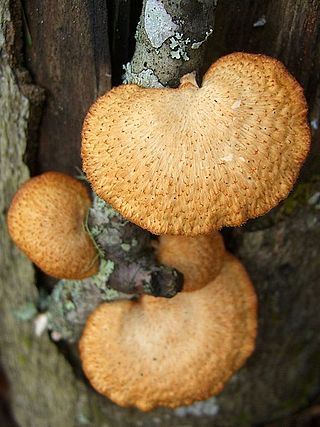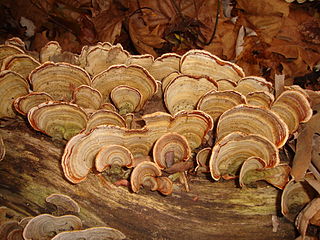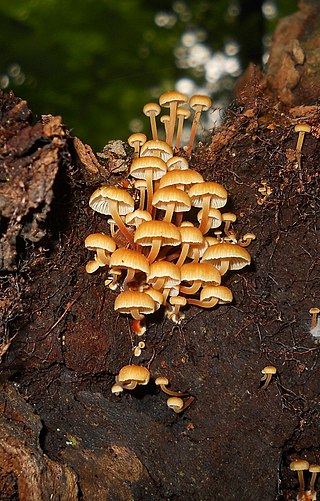
Laetiporus sulphureus is a species of bracket fungus found in Europe and North America. Its common names are crab-of-the-woods, sulphur polypore, sulphur shelf, and chicken-of-the-woods. Its fruit bodies grow as striking golden-yellow shelf-like structures on tree trunks and branches. Old fruitbodies fade to pale beige or pale grey. The undersurface of the fruit body is made up of tubelike pores rather than gills.

Fomitopsis pinicola, is a stem decay fungus common on softwood and hardwood trees. Its conk is known as the red-belted conk. The species is common throughout temperate Europe and Asia. It is a decay fungus that serves as a small-scale disturbance agent in coastal rainforest ecosystems. It influences stand structure and succession in temperate rainforests. It performs essential nutrient cycling functions in forests. As well as a key producer of brown rot residues that are stable soil components in coniferous forest ecosystems. It has been reported that mushrooms have significant antioxidant activity.

Tyromyces chioneus, commonly known as the white cheese polypore, is a species of polypore fungus. A widely distributed fungus, it has a circumpolar distribution, in temperate boreal pine forests, of Asia, Europe, and North America, causes white rot in dead hardwood trees, especially birch.

Hydnellum aurantiacum is an inedible fungus, commonly known as the orange spine or orange Hydnellum for its reddish orange or rusty red colored fruit bodies. Like other tooth fungi, it bears a layer of spines rather than gills on the underside of the cap. Due to substantial declines in sightings, this species is listed as critically endangered in the United Kingdom.

Lactarius vietus is a species of fungus in the family Russulaceae, first described by Elias Magnus Fries. It produces moderately sized and brittle mushrooms, which grow on the forest floor or on rotting wood. The flattened-convex cap can vary in shape, sometimes forming the shape of a wide funnel. It is typically grey, but the colour varies. The species has crowded, light-coloured gills, which produce white milk. The spore print is typically whitish, but also varies considerably. The mushrooms typically have a strong, acrid taste and have been described as inedible, but other authors have described them as consumable after boiling. L. vietus feeds by forming an ectomycorrhizal relationship with surrounding trees, and it favours birch. It grows in autumn months and is fairly common in Europe, North America and eastern Asia.

Neofavolus alveolaris, commonly known as the hexagonal-pored polypore, is a species of fungus in the family Polyporaceae. It causes a white rot of dead hardwoods. Found on sticks and decaying logs, its distinguishing features are its yellowish to orange scaly cap, and the hexagonal or diamond-shaped pores. It is widely distributed in North America, and also found in Asia, Australia, and Europe.

Phlebia is a genus of mostly crust fungi in the family Meruliaceae. The genus has a widespread distribution. Phlebia species cause white rot.

Lactifluus deceptivus, commonly known as the deceiving milkcap, is a common species of fungus in the family Russulaceae. It is found throughout eastern North America on the ground in coniferous forests near hemlock or deciduous forests near oak, and in oak-dominated forests of Costa Rica. It produces large mushrooms with funnel-shaped caps reaching up to 25 cm (9.8 in) in diameter, on top of hard white stems that may reach 4–10 cm (1.6–3.9 in) long and up to 3 cm (1.2 in) thick. The gills are closely spaced together and yellowish-cream in color. When young, the cap is white in all parts, but the depressed center becomes dull brownish in age and breaks up into scales. The edge of the cap has a roll of cottony tissue that collapses as the cap expands. The surface of the stem—especially near the base—has a velvety texture. The mushroom "bleeds" a milky white acrid latex when it is cut or injured. Similar milk-cap species with which L. deceptivus might be confused include Lactifluus piperatus, L. pseudodeceptivus, L. caeruleitinctus, L. subvellereus, Lactarius arcuatus and Lactarius parvulus.

Stereum ostrea, also called false turkey-tail and golden curtain crust, is a basidiomycete fungus in the genus Stereum. It is a plant pathogen and a wood decay fungus. The name ostrea, from the word 'oyster', describes its shape. With concentric circles of many colors, it highly resembles Trametes versicolor, turkey-tail, and is thus called the 'false turkey-tail'. The stemless fruiting body is shell-like and grows 1–7 cm (0.39–2.76 in) high. It is tough and inedible. It grows on tree bark. This fungus is native to the island of Java, Indonesia and has been misapplied to the North American Stereum species Stereum fasciatum, Stereum lobatum, and Stereum subtomentosum.

Picipes badius, commonly known as the black-footed polypore or black-leg, is a species of fungus in the family Polyporaceae. It causes a white rot of hardwoods and conifers. The species is found in temperate areas of Asia, Australia, Europe, and North America. It has a dark brown or reddish-brown cap that reaches a diameter of 25 cm (9.8 in), and a stipe that is often completely black or brown at the top and black at the base.

Guepiniopsis alpina, commonly known as the jelly cup, alpine jelly cone, or poor man's gumdrop, is a species of fungus in the family Dacrymycetaceae. The small, gelatinous Fruit bodies are orange and cone or cup shaped. Found in western North America and Iran, the fungus grows on decaying conifer wood.

Lentinellus montanus is a species of agaric fungus in the family Auriscalpiaceae. It is found at high elevations in the Pacific Northwest region of North America, where it fruits singly or in clumps on decaying conifer wood.

Phlebia incarnata is a species of polypore fungus in the family Meruliaceae. It is inedible.

Cudoniella clavus is a species of fungus in the family Helotiaceae. It was first described in 1805 by Johannes Baptista von Albertini and Lewis David de Schweinitz as Peziza clavus. British mycologist R. W. G. Dennis transferred it to Cudoniella in 1964. Fruit bodies of the jelly-like fungus consist of a disc-like cap measuring 0.4–1.2 cm with a thin stipe. They are usually cream in colour, sometimes with hints of ochre or violet. They grow on rotting twigs, stems, leaves, and cones that are submerged in water. Cudoniella clavus is a widespread and common species. It is inedible.

Xeromphalina kauffmanii is a species of agaric fungus in the family Mycenaceae. Found in North America, Costa Rica, and Japan, it was described as new to science in 1953. The type collection was made in Chelsea, Michigan, in June 1940. The specific epithet kauffmanii honors American mycologist Calvin Henry Kauffman.

Stropharia hornemannii, commonly known as the luxuriant ringstalk, or lacerated stropharia, is a species of agaric fungus in the family Strophariaceae. It is found in Europe and North America, where it grows as a saprophyte on rotting conifer wood. The specific epithet hornemannii honors Danish botanist Jens Wilken Hornemann, who made the first scientifically documented collections of the species. It is inedible and may be poisonous.

Phlebia radiata, commonly known as the wrinkled crust, is a common species of crust fungus in the family Meruliaceae. It is widespread in the Northern Hemisphere. It grows as a wrinkled, orange to pinkish waxy crust on the decaying wood of coniferous and deciduous trees, in which it causes a white rot. The fungus was first described scientifically in 1821 by Elias Magnus Fries.
Crustodontia is a fungal genus of uncertain familial placement in the order Polyporales. The genus was circumscribed in 2005 to contain the crust fungus Crustodontia chrysocreas. This species was originally described as Corticium chrysocreas by Miles Berkeley and Moses Ashley Curtis in 1873. Their description was as follows: "Subiculum bright yellow, thin; hymenium immarginate pallid, or yellow tinged with tawny." Crustodontia has a monomitic hyphal system, meaning it contains only generative hyphae, and these hyphae have clamp connections.

Nigroporus vinosus is a species of poroid fungus in the family Steccherinaceae, and the type species of the genus Nigroporus. Its fruit bodies have brownish caps with tinges of purple or red. The cap underside has a pore surface the same colour as the cap, and minute pores. Nigroporus vinosus has a pantropical distribution. It has been recorded from Africa, North America, Central America, South America, Asia, and Oceania. It is a wood-decay fungus that causes a white rot.

Sarcodontia setosa is a species of toothed crust fungus in the family Meruliaceae. It is a white rot species that is found in Europe and North America.





















